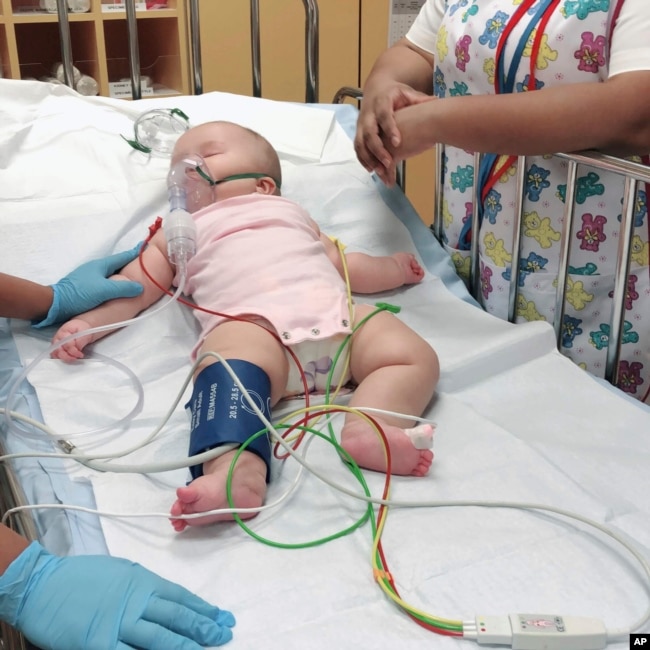Gene Therapy Delivers Treatment Directly to Brain

When Rylae-Ann Poulin was 1 year old, she did not crawl or make noises like other kids her age. A rare genetic disease prevented her from even lifting her head. Her parents took turns holding her all night to ease her breathing and help her sleep peacefully.
But months later, doctors in Taiwan treated the young patient’s brain directly, attacking the disease with genetic medicine. Now the 4-year-old is walking, running, swimming, reading and riding horses.
Rylae-Ann lives with her family in Bangkok, Thailand. She was accepted into a medical trial for a new method of gene therapy. Experts say the treatment holds great promise for treating several brain diseases.
The method was approved in Europe and the United Kingdom for a condition called AADC deficiency. The disorder damages communication systems among nervous system cells.
American drug company PTC Therapeutics plans to seek U.S. approval for the treatment this year.
The National Institutes of Health (NIH) says there are about 30 studies underway in the United States right now to test gene therapy to the brain. The studies target a number of diseases.
Dr. Krystof Bankiewicz at Ohio State University leads one such study on AADC deficiency. Others test treatments for brain diseases like Alzheimer’s, Parkinson’s and Huntington’s.
Difficulties remain, especially with diseases caused by more than a single gene. But scientists say evidence is growing in support of gene therapy to the brain.
“There’s a lot of exciting times ahead of us,” said Bankiewicz, a brain surgeon. “We’re seeing some breakthroughs.”
The most amazing of those breakthroughs involve Rylae-Ann’s disease. It is caused by changes in a gene needed for an enzyme that helps make neurotransmitters, the body’s chemical messengers. The one-time treatment provides a working version of the gene.
At around 3 months old, Rylae-Ann began having what her parents thought were seizures. Fluid sometimes got into her lungs after she ate, a condition that required hospital treatment. Doctors thought she might have epilepsy or cerebral palsy, more common brain diseases.

This photo provided by Judy Wei shows her daughter, Rylae-Ann Poulin, the first time she was admitted to an ICU. (Judy Wei via AP)
Later, her parents found a doctor who correctly identified Rylae-Ann’s condition. Her parents entered her into a gene therapy trial in Taiwan. The treatment requires doctors to operate directly on the brain. The doctors injected the genetic material using an extremely narrow tube.
“It gets put into the brain cells and then the brain cells make the (neurotransmitter) dopamine,” said Stuart Peltz, leader of PTC Therapeutics.
Company officials said all patients in their trials showed movement and thinking improvements. Some of them, Peltz said, could stand and walk and continue getting better over time.
Bankiewicz of Ohio State University also reported success in his NIH-financed study. He said all 40 or so patients involved saw big improvements.
Barriers to widespread use
Scientists say there are difficulties to face before this treatment becomes common for more brain diseases.
For example, the timing of treatment is an issue. Generally, earlier in life is better because diseases can cause more problems over the years. Also, more complex disorders like Alzheimer's are harder to treat with gene therapy.
A more basic barrier is cost. The price of gene therapies, paid for mostly by insurers and governments, can be in the millions. The one-time PTC therapy costs more than $3 million in Europe, for example.
But drugmakers say they want people to get the treatments they need. And researchers are hopeful they can clear the remaining scientific barriers to this method.
“So I would say gene therapy can be leveraged for many sorts of brain diseases and disorders,” said Ryan Gilbert. He is a biomedical engineer at New York's Rensselaer Polytechnic Institute. "In the future, you’re going to see more technology doing these kinds of things,” he added.
Words in This Story
breakthrough — n. a sudden increase in knowledge, understanding, etc.
dopamine — n. a compound present in the body as a neurotransmitter
insurer — n. a company that provides insurance
leverage — v. influence or power used to achieve a desired result
https://learningenglish.voanews.com/a/gene-therapy-delivers-treatment-directly-to-brain/6932450.html